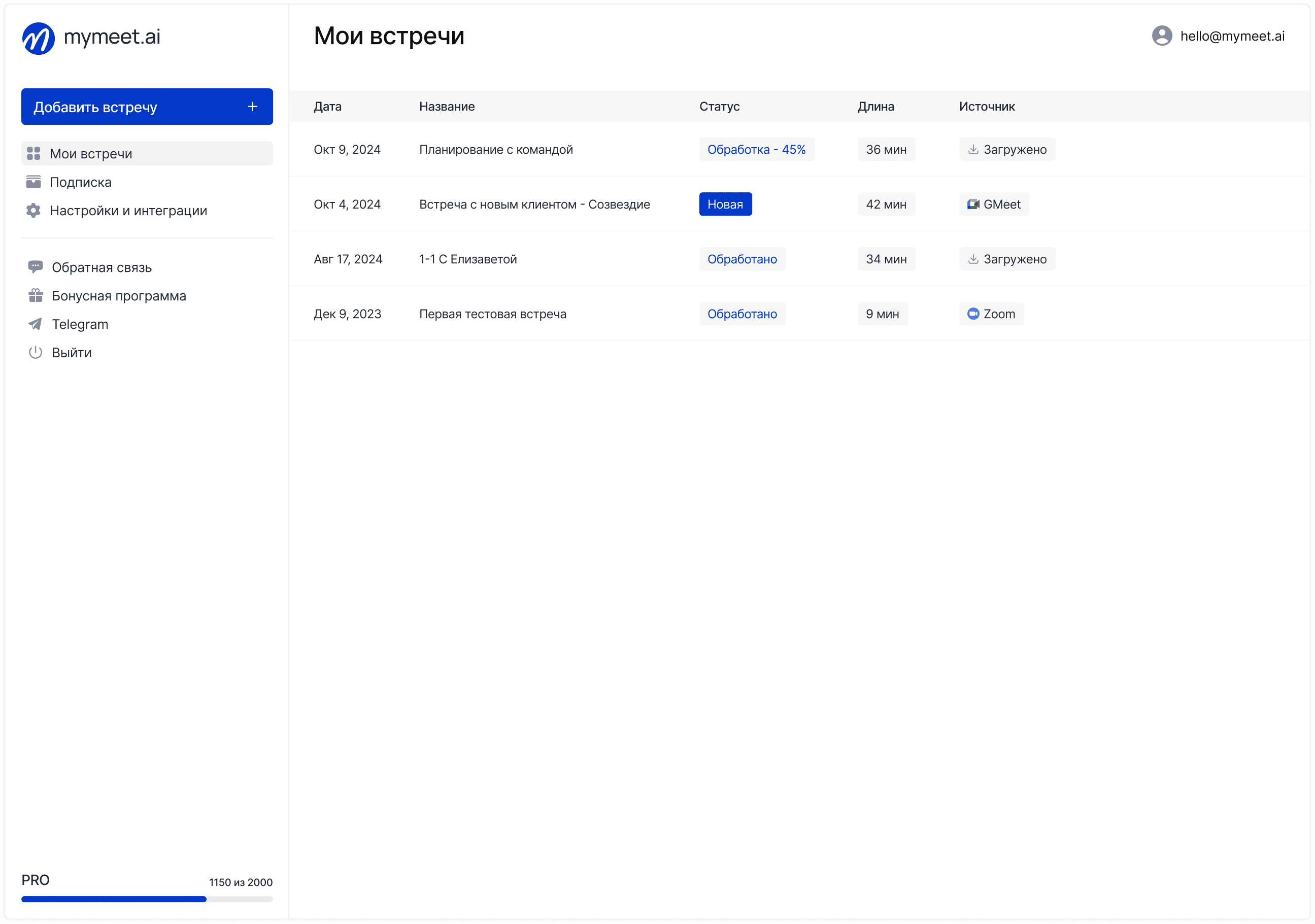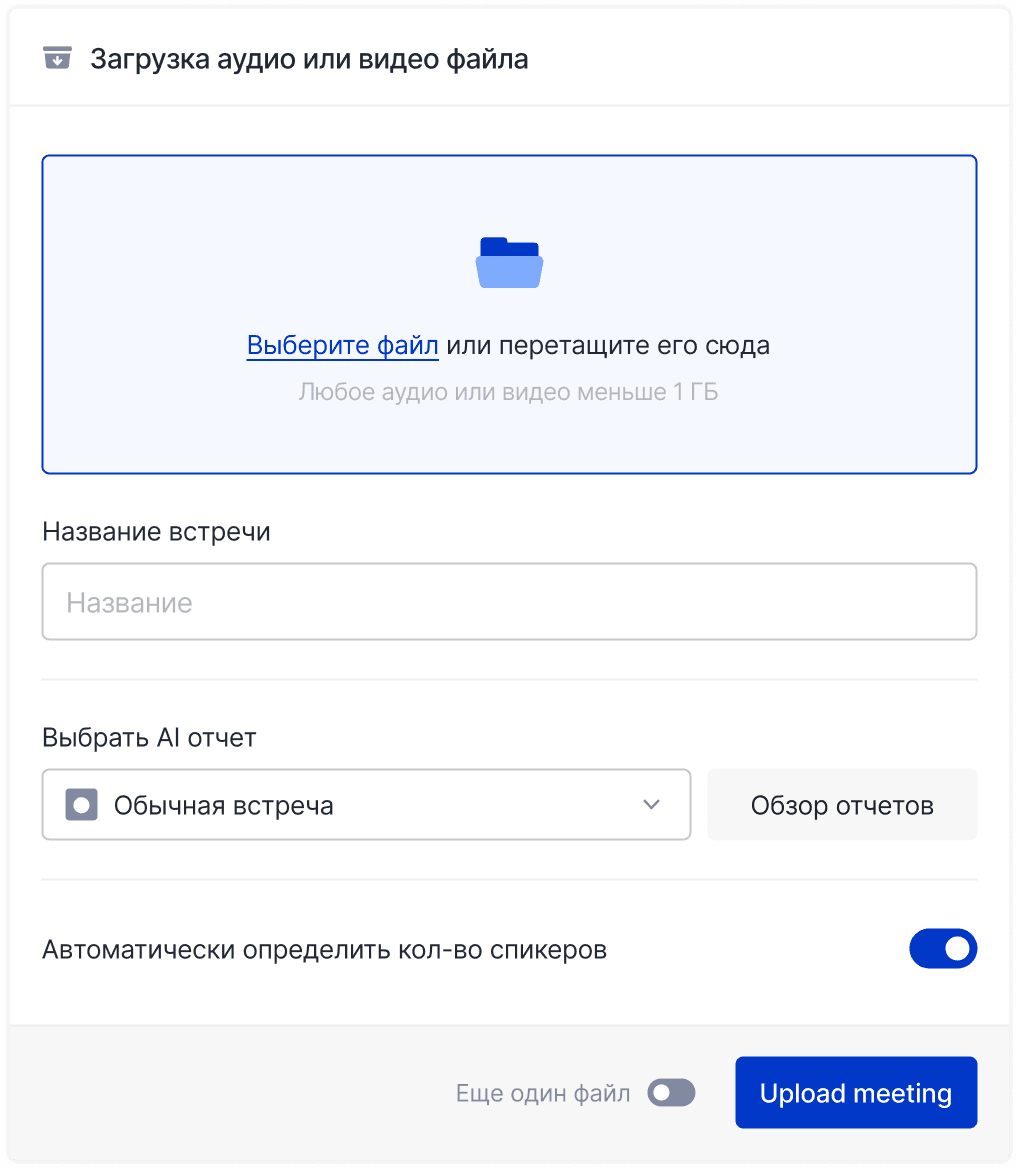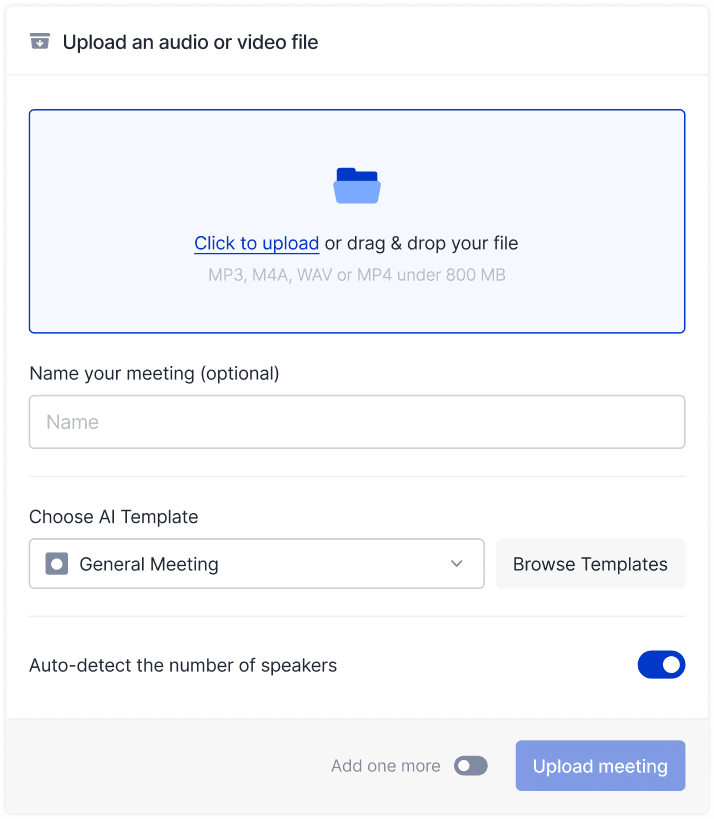Meeting Tips

Ilya Berdysh
Dec 19, 2024
Product manager gathers team for weekly meeting. Two hours discussing new features, development priorities, user feedback. By meeting's end, made ten important decisions about product development plans. A week later, it turns out developers understood priorities differently than manager planned, designer doesn't remember which exact screens need redesign, analyst forgot which metrics they agreed to track. Without structured capture, product meetings turn into lost time.
Hi there! The mymeet.ai team works with dozens of product development teams and knows what distinguishes effective meetings from useless conversations. Product meetings are critical team synchronization tool, but only when conducted properly and results are clearly documented. We'll cover product meeting types, show effective discussion structure, and explain how AI automates documentation.
What Are Product Meetings and Why Are They Needed
Product meetings are regular development team gatherings to discuss product development strategy, priorities, work progress, and problem-solving. This is main synchronization tool between product manager, developers, designers, analysts, and marketers.
Product Meetings' Role in Development
Product manager cannot manage alone. They need constant team synchronization—which features are being developed, what problems arose, what users are saying, where to move next.
Product meetings provide this synchronization. Instead of dozens of separate conversations, manager gathers team, discusses important questions, makes decisions collectively considering each participant's expertise.
Differences from Other Meeting Types
Product meetings differ from technical planning sessions and management strategic sessions.
From technical planning sessions—focus on product and users, not programming details. Discuss what to do and why, not how exactly to write code.
From strategic sessions—shorter planning period (weeks and months instead of quarters and year) and specific detail level. Discuss specific features, not entire company development directions.
From agile meetings—broader than one sprint, include long-term planning, feedback work, product development strategy.
Types of Product Meetings
Development teams conduct several types of regular meetings, each solving its own tasks.
Weekly Team Synchronization
Weekly meeting of entire product team for progress synchronization and current question resolution. Lasts 60-90 minutes, conducted on fixed weekday.
Participants: product manager, technical lead, lead designer, analyst, sometimes marketer
Goal: understand what was done during week, what problems arose, what's planned for next week
Meeting structure:
Product metrics overview for week—10 minutes
Progress on key features in development—20 minutes
Problems and obstacles requiring solution—20 minutes
Priorities for next week—20 minutes
Open questions—10 minutes
This is most frequent product meeting that keeps team synchronized.
Completed Feature Demonstration
Showing completed features to stakeholders—management, other teams, sometimes clients. Conducted every 2-4 weeks, lasts 60 minutes.
Participants: product team plus stakeholders (management, other product managers, key clients)
Goal: show what's done, get feedback, agree on next steps
Format:
Working feature demonstration (not presentation, but real product)
Explanation of what problem each feature solves
Feedback and question collection
Discussion of what to do next considering opinions
Demonstration is critical for verifying team is doing right things.
Product Development Planning
Creating development plan for quarter or half-year. Conducted quarterly, lasts 2-4 hours.
Participants: product manager, technical lead, lead designer, analyst, management
Goal: determine which features and initiatives to develop in next 3-6 months
What's discussed:
Past period results—what worked, what didn't
User feedback and analytics data
Business goals for next period
New feature proposals from team
Priority setting and plan formation
Resource and timeline assessment
Planning determines product development direction for months ahead.
User Research Review
Analyzing user research results—interviews, testing, surveys. Conducted as data accumulates, lasts 60 minutes.
Participants: product manager, user experience researcher, designer, analyst
Goal: understand user needs and problems, find product improvement ideas
Structure:
Research methods presentation
Key findings and conclusions
Quotes and user examples
Discussion of how to apply conclusions in product
Priority problem identification for solving
Research review turns qualitative user data into concrete actions.
Data and Metrics Analysis
Product analytics breakdown and key indicators. Conducted weekly or biweekly, lasts 45-60 minutes.
Participants: product manager, analyst, sometimes marketer
Goal: understand how users interact with product, which features work, where problems are
What's analyzed:
User activity indicators
Conversion on key paths
User retention and churn
Different variant tests and their results
Data anomalies and trends
Data analysis turns numbers into understanding of what's happening with product.
Why Product Meetings Become Ineffective
Typical problems turn useful discussions into time waste.
Absence of Clear Agenda
Manager creates meeting "Discuss product" without specific topics. Participants arrive not understanding what will be discussed. Chaotic conversation begins—someone raises design question, someone technical debt, someone wants to discuss development plans.
Without structure, meeting spreads across dozens of topics without depth in each discussion.
Unprepared Participants
Agenda exists, but discussion materials sent hour before meeting. Participants didn't manage to study analytics data, research results, new feature proposals. Half the time goes to initial information familiarization instead of discussion.
Individual Participant Dominance
At meeting, technical lead or active manager captures 80% of time. Other participants stay silent, their expertise unused. Designer could point out interface problem but hesitates to interrupt active colleagues.
Main meeting advantage is lost—team's collective expertise.
Decision Context Loss
Team discussed new feature and decided to do option A instead of B. Two weeks later, developer doesn't remember why chose exactly A—what arguments were, what risks discussed. Starts raising same questions again or implements incorrectly.
Without decision context capture, team loses valuable information.
Vague Tasks
Meeting ended, everyone dispersed. Nobody wrote down specifically who should do what next. A week later, it turns out critical task wasn't completed—everyone thought someone else was doing it.
Preparing for Effective Product Meeting
Proper preparation determines 70% of meeting success.
Forming Clear Agenda
Agenda should be ready 24-48 hours before meeting with specific topics and time.
Bad agenda:
Discuss progress
Talk about new features
Miscellaneous
Good agenda:
Activity metrics for week—10 minutes—Analyst
Progress on "New user onboarding" feature—15 minutes—Technical lead
Homepage test results—15 minutes—Product manager
Priority setting for next week—20 minutes—Everyone
Each topic has owner, time, expected discussion result.
Data and Materials Preparation
Participants must receive materials minimum day before meeting.
For data analysis:
Indicator dashboards
Change graphs
Variant test results
Anomalies requiring discussion
For development planning:
Feature proposals with justification
Resource and timeline estimates
Business priorities
User feedback
For research review:
Research report
Key user quotes
Interview video recordings (optional)
Meeting is time for discussing already studied materials, not first familiarization.
Choosing Right Participants
Not everyone should be at every product meeting.
Weekly synchronization—entire product team
Data analysis—product manager plus analyst, optionally designer and technical lead
Research review—product manager plus researcher plus designer
Development planning—product team plus management
Excessive participants get distracted, create noise, slow discussion.
Conducting Productive Product Meeting
Preparation done, participants gathered. Now leader's task is conduct discussion effectively.
Meeting Start Structure
First 5 minutes set tone for entire discussion.
What to do at start:
Remind meeting goal—why gathered, what result should be
Agenda overview—which topics, how much time for each
Rules establishment—how to ask questions, who leads meeting
Product manager or moderator should clearly define framework so discussion doesn't spread.
Focus on Data and Facts
Product decisions should rely on data, not subjective opinions.
Bad discussion: "I think users don't like this feature"
Good discussion: "Retention of users who used this feature is 15% lower. Here's data. In interviews, 7 out of 10 users complained about complexity"
Support each statement with metrics, research, specific examples.
Engaging All Participants
Leader should actively engage silent participants.
"Maria, as designer, how do you see this problem from interface perspective?"
"Sergey, you're technical lead, is this timeline estimate realistic?"
"Does analytics have data on this question? Let's look at numbers"
Each participant invited for their expertise—use it.
Capturing Decisions in Real Time
Most critical—write down what was decided right during discussion.
Assign person responsible for minutes or use automatic recording tools. Formulate each decision clearly:
Bad capture: "Discussed user onboarding"
Good capture: "Decision: redesigning new user onboarding screen. Designer prepares new variant by Friday. Development starts in next sprint"
Automating Product Meetings with AI
Manual minutes keeping takes time and attention. Product manager simultaneously leads discussion and tries to write down key points—result is either moderation suffers or details are lost.
Mymeet.ai automates all meeting documentation work.
✅ Automatic meeting recording—system connects on schedule from calendar
✅ Russian transcription—complete text transcript with participant separation
✅ Decision and task extraction—AI finds all agreements automatically
✅ Specialized reports—templates for different product meeting types
✅ Feedback analysis—system highlights mentions of user problems and wishes
✅ Knowledge base—search through all past discussions via AI chat
Case Study: How ProductLab Team Saves 12 Hours on Documentation
ProductLab team of 8 people develops educational platform. Conducted 15-20 product meetings monthly—weekly synchronizations, data reviews, research discussions. Product manager spent 30-40 minutes after each meeting on minutes formatting with decisions and tasks.
Problem: Manager simultaneously moderated meeting and tried to write down important things. Result was either missing discussion details or losing conversation thread. After meeting had to restore decisions from memory—half the nuances were forgotten. Team spent 12+ hours monthly just on minutes formatting.
Solution: Implemented mymeet.ai with automatic connection through Google Calendar. System recorded all product meetings and created structured reports with decisions, tasks, user problem mentions.
Results:
Saving 12 hours per month on documentation
Manager fully focused on discussion moderation
Team receives detailed minutes 10 minutes after meeting
History of all product decisions available for search
New team members quickly enter context through past meeting recordings
Product Meeting Best Practices
Effective teams follow proven meeting conduct principles.
Start with Data
Each discussion should begin with facts, not opinions. Before discussing new feature, show data—how many users requested it, what alternative solutions they use now, how this affects key metrics.
Data-based decisions are harder to dispute and easier to justify to management.
Limit Discussion Time
Set hard limits on each agenda topic. If discussion drags on—capture current state and move details to separate meeting with needed people.
Better to discuss all planned topics superficially and deepen later than spend entire meeting on one question.
End with Concrete Actions
Each meeting should end with clear list of who does what next. Voice aloud all tasks with responsible parties and deadlines. Get confirmation from each executor.
Without concrete actions, meeting was useless—just discussed and dispersed.
Regularly Review Format
Once a quarter discuss meeting effectiveness with team. Which meetings are useful, which can be shortened or canceled. What to improve in conduct format.
Meeting format should evolve with team and product growth.
Conclusion
Product meetings are main development team synchronization tool. Weekly synchronizations keep team informed of progress, feature demonstrations collect feedback, planning determines development direction, data and research reviews help make fact-based decisions.
Meeting effectiveness depends on preparation, clear structure, data focus, and result documentation. Automation through AI frees manager from minutes routine and allows focusing on discussion moderation.
Ready to automate product meetings? Try mymeet.ai for free—180 minutes of automatic recording and analysis without card attachment.
Frequently Asked Questions About Product Meetings
How often to conduct product meetings?
Weekly synchronization—every week to maintain work rhythm. Feature demonstration—every 2-4 weeks when there's something to show. Development planning—quarterly to determine direction. Data analysis—weekly or biweekly. Frequency depends on team size and development pace.
How long should product meeting last?
Weekly synchronization—60-90 minutes maximum. Data analysis—45-60 minutes. Development planning—2-4 hours quarterly. Feature demonstration—60 minutes. Meetings longer than two hours require hourly breaks to maintain concentration.
Who must be invited to product meetings?
Mandatory: product manager, technical lead, lead designer. Often needed: analyst, user experience researcher, marketer. Optional: management for important decisions, developers for technical discussions. Composition depends on specific meeting topic.
How to engage silent participants?
Ask direct questions to specific people. Use structured formats where everyone speaks in turn. Give time to think before answering—"Let's take two minutes for everyone to write their thoughts." Create safe atmosphere where any opinions can be expressed without judgment.
Is agenda needed for short meeting?
Yes, even 30-minute meeting requires structure. Agenda can be simple list of 2-3 items, but participants should know what will be discussed. Without agenda, even short meeting turns into unstructured conversation.
How to make decisions when team disagrees?
First ensure everyone understands data and arguments identically. Let speak each side. Verify assumptions—often disagreements from different fact understanding. If consensus impossible—product manager makes decision and takes responsibility. Capture all sides' arguments for future verification.
What to do with participants who constantly are late?
Start strictly on time without waiting for latecomers. Don't repeat what was said for latecomers—they can read in minutes. Talk personally with chronically late about punctuality importance. Review meeting time if most are late—possibly inconvenient time.
How to document product meetings effectively?
Assign responsible for minutes or use automatic tools like mymeet.ai. Capture in real time key decisions and tasks. Structure minutes by agenda topics. Send quickly—within several hours after meeting while memory is fresh.
Can product meetings be conducted asynchronously?
Some types can be replaced with asynchronous communication. Data analysis—send dashboard with comments, collect questions in writing. Feature demonstration—record video and collect feedback through form. But planning and complex question resolution require synchronous discussion for effectiveness.
How does automation help product meetings?
Mymeet.ai automates meeting recording and transcription, decision and task extraction, structured report creation. Product manager fully focused on discussion moderation instead of trying to write down important things. Team receives detailed minutes minutes after meeting. Knowledge base from past meetings helps new participants quickly enter context.
Ilya Berdysh
Dec 19, 2024








